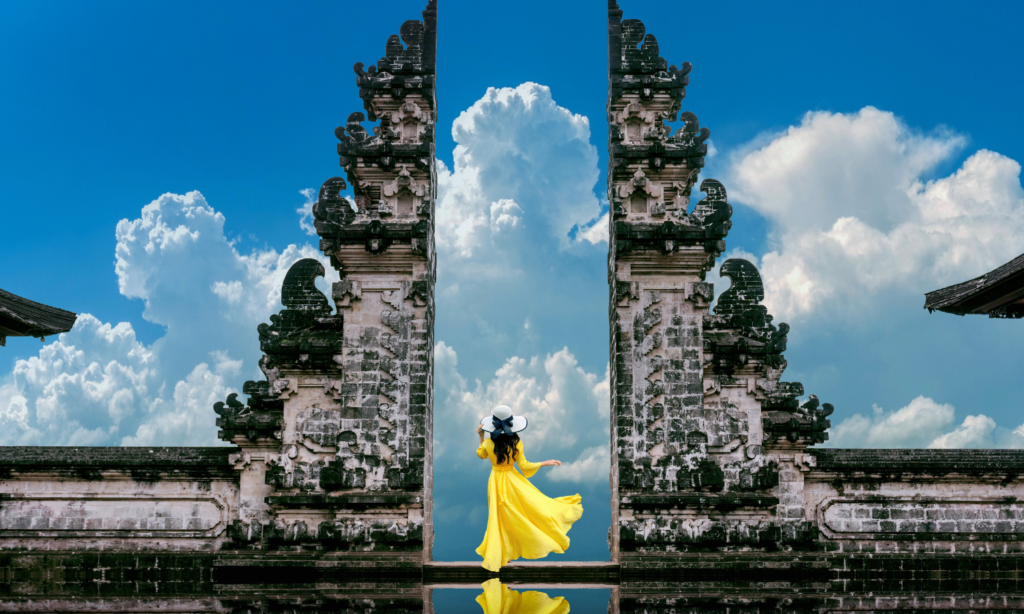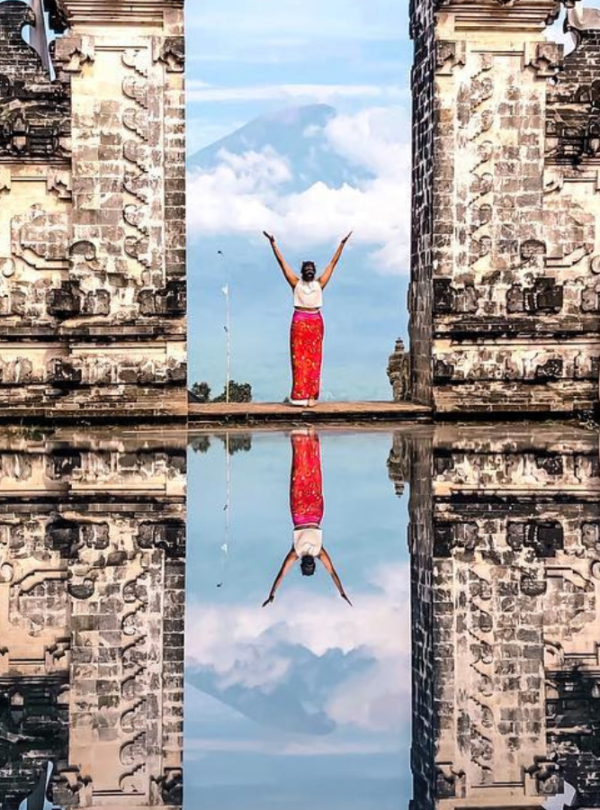Overview
Plan a trip to the amazing East Bali. Choose from tour options focusing on Besakih Temple, Tirta Gangga, and Lempuyang Temple, as well as a selection of interesting waterfalls.
Visit Besakih Temple, the “Mother of all temples” in Bali and the most important holy place for Balinese Hindus. Explore the large temple complex and admire its stunning architecture.
Next, head to Tirta Gangga, a beautiful water park with swimming pools, fountains, and stunning statues. Relax and enjoy the natural beauty of Bali.
Visit Lempuyang Temple, famous for the gate of heaven, or “Gate of Heaven,” which offers spectacular views of Mount Agung.
Choose from a selection of interesting waterfalls. Visit Kanto Lampo Waterfall, unique because the water flows through the gaps in the rocks, creating beautiful lighting effects.
Visit Goa Raja Waterfall, located inside a cave and having a clear natural pool. Finally, visit Tukad Cepung Waterfall, surrounded by high cliffs and offering a challenging trekking experience.
Discover the "Mother of all temples" at the Besakih Temple
- Visit the stunning water park of Tirta Gangga
- Take in the views of Mount Agung from the Lempuyang Temple
- Choose from a selection of waterfalls to visit Relax in the natural beauty of Bali
itenerary
We will pick you up at the hotel lobby according to the confirmed location according to your order.
Penataran Agung Lempuyang Temple is a Hindu temple complex located on the slopes of Mount Lempuyang in Karangasem Regency, eastern Bali. This temple is one of the Sad Kahyangan Jagat or six main temples in Bali which are considered the spiritual pillars of the Island of the Gods.
The main attractions of Penataran Agung Lempuyang Temple are:
The "Heaven" Gate (Candi Bentar): This iconic gate has become very popular because of its dramatic view with the majestic backdrop of Mount Agung when the weather is clear. Many tourists come here to take pictures with this stunning view.
Sacred and Natural Location: Located at a high altitude, this temple offers a calm, sacred atmosphere and is surrounded by natural beauty. To reach the main temple, visitors must climb hundreds of steps, which is considered a spiritual journey and a test of patience.
Authentic Balinese Architecture: This temple displays typical Balinese architecture with various sacred buildings (pelinggih) decorated with intricate carvings and religious symbols.
Spiritual and Cultural Value: As one of the important temples in Bali, Lempuyang Temple has high spiritual and cultural value for the Balinese Hindu community. This temple is a place of worship and the implementation of various religious ceremonies.
Stunning Views: In addition to the view of Mount Agung from the gate, from the height of the temple also offers beautiful views of East Bali, including the hills and ocean.
Tirta Gangga Water Palace is a stunning former royal palace located in the eastern part of Bali, Indonesia, about 5 kilometers from Karangasem. The name Tirta Gangga translates to "water of the Ganges," a sacred river in Hinduism, reflecting the holy nature of the water here.
Royal Water Gardens: Built in 1946 by the late Anak Agung Anglurah Ketut Karangasem, the last Raja (King) of Karangasem, the palace features elaborate water gardens, swimming pools, and fish ponds. It was designed as a place for relaxation, worship, and bathing.
Natural Springs: The complex is fed by natural springs, and the water is considered holy by the local people, believed to have healing powers. This water flows through the various pools and fountains within the palace grounds and also supplies drinking water to the surrounding villages and rice fields.
Ornamental Ponds and Fountains: The gardens are adorned with intricately carved stone statues of deities, mythical creatures, and animals, often incorporated into fountains and pond features. The most iconic image of Tirta Gangga is likely the series of stepping stones shaped like mythical creatures rising out of the main pond.
Swimming Pools: Tirta Gangga has two public swimming pools where visitors can enjoy a refreshing dip in the cool, clear spring water. One pool was historically reserved for the royal family.
Lush Gardens: The water features are surrounded by beautifully landscaped gardens with vibrant flowers, manicured lawns, and shady trees, creating a tranquil and picturesque atmosphere.
Spiritual Significance: Besides being a place of beauty and recreation, Tirta Gangga holds spiritual significance for the Balinese people. It's a place for ceremonies and where the holy water is used for religious rituals. There's also a temple (Patirthan) within the complex, further emphasizing its sacred nature.
Historical Significance: The palace is a testament to the vision and artistry of the Karangasem Kingdom. Despite being partially destroyed by the eruption of Mount Agung in 1963, it was rebuilt and restored, standing today as a significant cultural and historical landmark.
Pura Besakih, often referred to as the "Mother Temple of Bali," is the largest, most important, and holiest temple complex on the island. Situated on the southwestern slopes of Mount Agung, Bali's highest and most sacred volcano, Besakih is not just a single temple but a vast complex comprising 23 separate temples spread across six levels.
Spiritual Heart of Bali: Besakih is the central and most sacred temple for the Balinese Hindu community. It is the focal point for major religious ceremonies and a pilgrimage site for devotees from all over Bali. Connection to Mount Agung: Its location on the sacred mountain reinforces its spiritual significance. Mount Agung is believed to be the spiritual center of the universe, and Besakih's placement aligns with Balinese Hindu cosmology, acting as a bridge between the divine and earthly realms. Temple of All Castes: Unlike some other temples that might cater to specific groups, Besakih is open to all Hindu devotees, symbolizing unity and harmony. Historical Importance: The site's sanctity likely predates the arrival of Hinduism in Bali. Stone foundations of some temples resemble megalithic stepped pyramids, suggesting a history stretching back over 2,000 years. It was certainly a significant Hindu place of worship by the 13th century and became the state temple of the Gelgel dynasty in the 15th century.
Complex of Temples: The 23 temples within the complex each have their own unique function and are dedicated to different deities, ancestral spirits, and aspects of nature. Pura Penataran Agung: This is the main and largest temple within the complex, serving as the central place of worship. It features three main shrines (Padmasana) dedicated to the Hindu Trinity: Shiva (the destroyer), Brahma (the creator), and Vishnu (the preserver). Terraced Design: The temples are built on six levels, terraced up the slope of Mount Agung. This design is aligned along a single axis, symbolically leading the spiritual person upwards towards the sacred mountain. Architectural Features: Besakih showcases traditional Balinese temple architecture with towering multi-tiered meru (pagoda-like shrines), intricately carved stone sculptures, and decorative gateways (candi bentar and kori agung).
Gua Raja Waterfall is a relatively lesser-known but captivating natural attraction located in the Gianyar regency of Bali, often described as a hidden gem. Its name, "Gua Raja," translates to "King's Cave Waterfall," hinting at the unique feature that sets it apart from many other waterfalls in Bali.
Waterfall Emerging from a Cave: The most distinctive characteristic of Gua Raja Waterfall is that the water plunges out from the mouth of a small cave. This creates a dramatic and somewhat mysterious scene, unlike typical waterfalls that cascade down open rock faces.Hidden and Secluded Atmosphere: Due to its location and the fact that it's not as heavily promoted as some of Bali's more famous waterfalls, Gua Raja often offers a more tranquil and secluded experience. This makes it ideal for those seeking a peaceful escape from the crowds. Lush Green Surroundings: The waterfall is nestled within a verdant and natural environment, surrounded by tropical vegetation, creating a beautiful and refreshing ambiance. The air is often cool and moist. Natural Pool for Swimming: At the base of the waterfall, there is typically a natural pool where visitors can enjoy a refreshing swim. The water is usually cool and clear, offering a welcome respite from the Bali heat. The Cave Itself: While you can't venture deep into the cave, the sight of the water emerging from its dark opening is a unique and intriguing feature. It adds an element of exploration and wonder to the visit.Relatively Untouched Beauty: Compared to some more commercialized waterfalls, Gua Raja often retains a more natural and untouched feel, allowing visitors to connect more directly with the raw beauty of Bali's landscape.
INCLUDES/EXCLUDES
COST INCLUDES
- Hotel pickup and drop-off
- Lunch
- Bottled water
- English-speaking guide
COST EXCLUDES
- Entrance fees
- Personal expenses
- Tips













